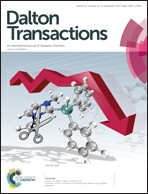A series of 3D metal organic frameworks based on [24-MC-6] metallacrown clusters: structure, magnetic and luminescence properties†
Abstract
Four isostructural metal organic frameworks (MOFs), namely [Co6(HipO)6]·6H2O (1), [Mn6(HipO)6]·6H2O (2), [Cd6(HipO)6]·6H2O (3) and [Zn6(HipO)6]·7H2O (4) (H3ipO = 2-hydroxyisophthalic acid), were synthesized and structurally characterized. They have a 3D (4,6)-connected framework based on [24-MC-6] metallacrown clusters ([24-MC-6]-based MOFs). The arrangements of the 24-MC-6 metallacrown SBUs show a regular change indicated by the orientation of their symmetry axes, resulting in a special dense packing mode different from other [24-MC-6]-based MOFs. The analysis of SQUID measurements reveal that compound 1 displays the dominant antiferromagnetic exchanges in 300–10 K between the adjacent Co(II) ions and a ferromagnetic-like behavior at lower temperatures, whereas compound 2 shows an antiferromagnetic interaction between the adjacent Mn(II) ions. Compound 1 exhibits a magnetocaloric effect (MCE) with the resulting entropy change (−ΔSm) of 15.20 J kg−1 K−1 for ΔH = 50 kG at 6 K, which is the highest value among the cobalt-based MOFs with MCE reported so far. The luminescence properties of compounds 3 and 4 were studied, both of them exhibit photoluminescence in the solid state at room temperature which can be ascribed to intraligand π→π* transitions.
![Graphical abstract: A series of 3D metal organic frameworks based on [24-MC-6] metallacrown clusters: structure, magnetic and luminescence properties](/en/Image/Get?imageInfo.ImageType=GA&imageInfo.ImageIdentifier.ManuscriptID=C4DT01593B&imageInfo.ImageIdentifier.Year=2014)

 Please wait while we load your content...
Please wait while we load your content...